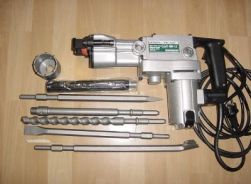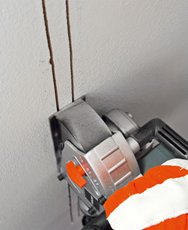Categories: Electrician at home, Safety precautions
Number of views: 60881
Comments on the article: 8
Portable power receivers: connection features, electrical safety classification
 How many outlets in your apartment? Five? Ten? More? And how many of them are always free? I bet that at least half. What are they for?
How many outlets in your apartment? Five? Ten? More? And how many of them are always free? I bet that at least half. What are they for?
These sockets are most often used for connecting various portable power consumers. To distinguish them from the rest is quite simple: they can be connected anywhere, without really bothering - there would be a 220-volt outlet.
Most typical portable power - this is a manual power tool: grinder, drill, hammer drill etc. Something must be done somewhere: they hooked the tool to carrying and worked under any conditions. The work is over - the tool is carried away in a long time, al will soon come in handy in a completely different place.
But portable power receivers are not only a power tool. Televisions, tape recorders, vacuum cleaners can also be considered portable electrical receivers: for their installation, they do not require almost anything except the supply voltage. It turns out that any living room is simply full of portable power consumers. But they require a special relationship, and not everyone knows about it.
 Any portable power tool is connected to the network only with electric plugs. Everything is clear: no terminal blocks, all the more twists, no connectors like a mother, no clamps and separate circuit breakers: only a 220-volt plug.
Any portable power tool is connected to the network only with electric plugs. Everything is clear: no terminal blocks, all the more twists, no connectors like a mother, no clamps and separate circuit breakers: only a 220-volt plug.
The power cable of the portable power receiver, without any options, must be copper and flexible, and its insulation must be durable. Flexibility and durability of the cable are needed because the portable power receiver is often moved without disconnecting from the network. In relatively rare cases, when strength is of particular importance, a cable with copper and steel conductors, for example, field, is used.
Factory insulation of cables for portable power receivers is usually PVC plastic - it is both strong and durable. However, if you intend to operate a power tool at very low temperatures, it is better to replace this cable with a rubber one, for example KGhl. PVC shows itself very poorly in the cold: it bursts and tears, it becomes hard "like a stick." Rubber insulation does not lose so much flexibility in the cold, but overall it is less durable and strong.
Portable power consumers and, above all, power tools are strictly divided into 4 classes of electrical safety. The higher the class, the safer the power receiver is in operation and in the more dangerous rooms it can be used.
The first of these classes is zero (0). This class does not provide any security measures at all. There is no grounding, it feeds on a dangerous voltage of 220 volts, and the insulation can be single. Using such electrical appliances is undesirable. But if you really have to deal with them, then you need to have dielectric bots and gloves, or include in the mains RCD. In rooms with at least one factor of increased danger (humidity, temperature, chemically aggressive environment), it is impossible to use electrical receivers of class zero.
 Second class (I) - has a grounding contact on its plug and is connected to a three-wire network. Grounding protects a person from electric shock through a live casing. Power receivers that comply with class I are indicated by the earth sign in the circle.
Second class (I) - has a grounding contact on its plug and is connected to a three-wire network. Grounding protects a person from electric shock through a live casing. Power receivers that comply with class I are indicated by the earth sign in the circle.
Third Grade (II) - no longer provides for grounding contact, but assumes double reinforced cable insulation. In general, this class is the most numerous.Safety in the operation of this type of portable power consumers is achieved by connecting to isolation transformer.
Thus, even if a person directly grabbed onto one of the conductors, it will not be shocked, since there is no circuit, and the transformer neutral is isolated. There is only one “BUT”: the isolation transformer, most often, is neglected, and in everyday life it is almost impossible to install. Class II electrical receivers are indicated by a double square on the chassis.
Well and the safest class of power consumers - III. These power consumers are powered by low voltage - up to 50 volts ac. Such power consumers are connected again through a step-down isolation transformer.
Most often in especially dangerous rooms, such as, for example, raw basement, a network with sockets and lamps is specially carried out, taking power from just such a transformer. Thus, any possibility of electric shock is excluded. The designation of power receivers of this class is a rhombus with a III sign inside.
Alexander Molokov
See also at e.imadeself.com
:
